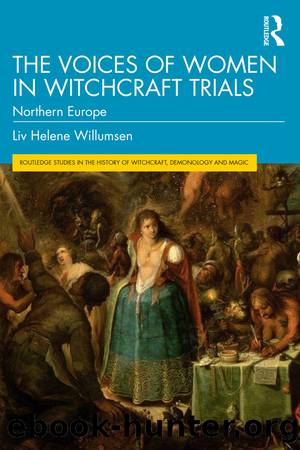The Voices of Women in Witchcraft Trials by Liv Helene Willumsen;

Author:Liv Helene Willumsen;
Language: eng
Format: epub
Publisher: Taylor & Francis (Unlimited)
Published: 2022-08-15T00:00:00+00:00
8
SwedenâKullen, BlÃ¥kulla, and the Water Man
DOI: 10.4324/9781003255406-8
In Sweden, the intensity of witchcraft persecution was average compared to that in other European countries.1 The witchcraft trials were to a large extent characterized by maleficium, minor offences, and few death sentences. Most of the trials took place in the southern part of the country. However, there are some exceptions, most famously the BlÃ¥kulla2 trials, in which demonological ideas were central. Sweden was divided into three regions: Götaland in the south, Svealand in the middle, and Norrland in the north. The BlÃ¥kulla trials began in Dalarne,3 a province in the north of Svealand, and spread to Norrland, Uppland, and Stockholm from 1668 to 1676.4 During these trials, a large number of child witnesses testified that they were abducted to a witchesâ sabbath at a hill called BlÃ¥kulla. The children denounced many adults.
I have chosen three Swedish witchcraft trials that exemplify chronology, different locations, and differences in content. The first is the trial of Ingegärd Andersdotter, which took place in 1594 in Kronoberg District,5 in SmÃ¥land in Götaland. The second is the trial of Karin Persdotter, which took place in 1653 in Uppvidinge municipality, also situated in SmÃ¥land. The third is the trial of Karin, wife of Daniel Dantz, 1673â74. It took place before the local court in the town of Sundsvall in Norrland, close to the coast of the Gulf of Bothnia. The trial was part of the BlÃ¥kulla trials.
This timeline provides Swedish witchcraft trials occurring over a period of eighty years. It includes trials from Götaland and Norrland. As for content, the voices of women, in the accused personsâ confessions as well as in witnessesâ testimonies, display a range of ideas related to demonological witchcraft and maleficent witchcraft, in addition to beneficent magic (healing). The female voices heard in the trials provide glimpses of how new ideas about witchcraft connected to older ones in the mental realm of common people in seventeenth-century Sweden.
Both the confessions and the testimonies are narratives, and are formed according to narrative structures. Analysis of courtroom discourse will take into account the way these narratives were told and what kind of strategies the accused women and the witnesses used when communicating in the courtroom. The women lived in predominantly oral societies, and orality features colour the language. These also show an individualized language: each of the accused has put her own stamp on her formulations. The confessions also make it possible to trace leading questions posed during interrogation, thus echoing the interrogatorâs voice. In all confessions, new and learned ideas alongside with traditional ideas come to the fore.
The chapter aims at examining various accents of the female voices, particularly in the confessions. Through the close reading of confessions, a possible turning point of the trial will be looked for, as several trials start with the accused person denying witchcraft and then suddenly changing to confessing to it. This movement often reveals emotions, as a strong and protesting accent of the accused personâs voice is replaced by a subdued and frightened accent.
Download
This site does not store any files on its server. We only index and link to content provided by other sites. Please contact the content providers to delete copyright contents if any and email us, we'll remove relevant links or contents immediately.
Room 212 by Kate Stewart(4108)
The Crown by Robert Lacey(4108)
Endurance: Shackleton's Incredible Voyage by Alfred Lansing(3848)
The Iron Duke by The Iron Duke(3641)
The Rape of Nanking by Iris Chang(3518)
Killing England by Bill O'Reilly(3458)
Joan of Arc by Mary Gordon(3261)
Say Nothing by Patrick Radden Keefe(3063)
I'll Give You the Sun by Jandy Nelson(2843)
Hitler's Monsters by Eric Kurlander(2734)
Shadow of Night by Deborah Harkness(2720)
Margaret Thatcher: The Autobiography by Thatcher Margaret(2687)
Mary, Queen of Scots, and the Murder of Lord Darnley by Alison Weir(2679)
Darkest Hour by Anthony McCarten(2649)
Blood and Sand by Alex Von Tunzelmann(2610)
Red Famine: Stalin's War on Ukraine by Anne Applebaum(2466)
Eleanor & Park by Rainbow Rowell(2395)
The One Memory of Flora Banks by Emily Barr(2349)
Book of Life by Deborah Harkness(2265)
